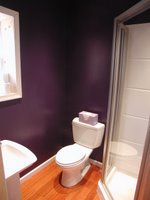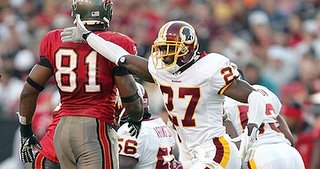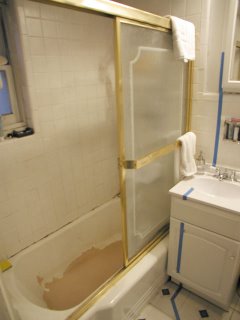This post features a funny story and two bits of good news. Just so you know.
Zach and I had one of our myriad doctor's appointments at (ahem) 8 o'clock this morning. This meant leaving the house by 7AM, which meant getting up at 6AM.
If you are a naturally early riser, or have kids who have converted you to being an unnaturally early riser, or didn't have to sleep with a surgical drain (me) or a raging headcold (Zach) last night, then you might think that springing out of bed at 6AM is a non-issue.
Well, first there's the springing part. You don't really spring so much with a raging headcold. And you definitely don't spring with a surgical drain in.
See, a surgical drain is basically a bit of flexible plastic tubing with a hand-grenade-like bulb at the end. It looks like
this. At least, the part you can see looks like that. There's also another part that is attached to the top of the tubing that you can't see because it's
inside your body. The whole point of the drain is to minimize fluid build-up at the site of the surgery. So any fluid that does build up is immediately drawn outside, through the tube, to the bulb. Where, um, you have to empty it periodically and measure how much of it there is. Which, if you're squeamish (and I am, big-time), is a bit of a challenge. (This is why Zach said, "unlike 4 years ago, she can empty her drain by herself this time, thank you very much" in the post below. He had the great pleasure last time around. I figured it was my turn this time. So I did it. Three times. Thank you very much.)
As I was saying, you can't really spring with a surgical drain in. First of all, it's secured to your body with a few stitches. And it's buried under a wad of gauze strategically located right under your arm, which makes it impossible to lower your arm all the way or find
any comfortable position whatsoever. And then your whole midsection is wrapped, mummy-like, with an Ace bandage. And, as an added attraction, the drain is attached to the Ace bandage with a big safety pin so that instead of hanging freely (and pulling on the stitches), the bulb is suspended somewhere around your belly button.
So on top of looking extra-attractive and feeling fabulous, it's pretty hard to move with anything approaching a spring in your step. Getting out of bed in the first place is a major feat of choreography.
First, while lying on your back with a pillow placed ineffectually under your left arm, you bend your right leg and hook your right arm under your knee. Then, in one semi-smooth maneuver, you swing your right leg down, hold tight with your right arm, and contract your stomach muscles so that you see-saw into an upright position (without getting stuck in the middle) and can step onto the floor.
OK, maybe this
is springing out of bed after all.
It is now approximately 6:10AM. You have not been allowed to shower since the surgery, two days ago. You are, shall we say, not feeling as fresh as you might like, especially if you have to leave your pajamas and your bed and venture into town to see a brand-new doctor as well as your surgeon (who is used to seeing not-so-fresh post-surgical patients with unwashed, bed-head hair and attractive plastic tubing emanating from their bodies).
Showering is out (as is raising your left arm above your head—not that you could do that anyway), but sponge baths are allowed. Of course, you have no bathroom at this point. (See
"Happy Birthday, Jody!" below.) So you gather up your sponge-bath supplies and head to the bathroom of your upstairs neighbor, Bill (hi, Bill!), who has kindly offered up his loo in lieu of yours while he is out of town and yours is out of, you know, a toilet, a sink, and a shower.
And you give yourself a very halting sponge bath (no pictures, sorry) with your very limited mobility.
So now you are clean(er), but you are carrying a wet towel and a little bottle of bath gel, not to mention your pajamas and underwear. And you know that you will be putting on semi-real clothes as soon as you get downstairs. And it's maybe 6:30AM, and you know that Bill is safely in California and that the two guys rebuilding your bathroom are not due for two and half hours, and you're pretty sure that Erin and Sara (hi, Erin and Sara!) up on the third floor are still asleep. And the thought of putting on your not-so-fresh pajamas only to take them off again five minutes later is less than appealing. (You are already tuckered out from your not-so-great night's sleep and the contortions required for the sponge bath, and you know that more contortions will be required to get dressed in semi-real clothes.)
So you decide to risk it and walk downstairs naked (except for the surgical drain, the gauze, and the mummy-like Ace bandage around your midsection).
And a miracle occurs, and nobody materializes on the stairs or in the hallway to see you in all your post-surgical glory.
Hooray.
(That was the funny story. Well, anyway, it seemed funny at 6:30 this morning.)
Here is the good news:
A few hours later, we went to see my fantabulous surgeon, and she removed the drain (with a little local anesthesia) and most of the gauze and the entire Ace bandage. And there was much rejoicing.
And here is the other good news:
The two guys rebuilding our bathroom (hi, Lloyd and Neville!) are tantalizingly close to installing our very own brand-new toilet. (Shower and sink—and photos—to follow soon thereafter.) In fact, they would have installed it tonight had they not been missing one small part. In fact, they wanted to go out and get the part so they could finish installing it so that I wouldn't have to commute to the bathroom for another night, but I'm feeling so good in my drain-free state that we told them to call it a night and finish up tomorrow (when, coincidentally, Bill returns from his trip).
Goodbye plastic, hello porcelain!
 Before, the bathroom was tiny and filthy. We inherited a loo that was a horrible shade of pink. One weekend while Jody was out of town, I painted every tile, every fixture, every inch of porcelain with an epoxy/paint combination called Tough as Tile. Which should have actually been called Tough as crappy Tile, since it lasted less than a year before it began to flake. It flaked so badly in the bathub that the tub's floor was eventually revealed (see the pink?). Also, Tough as Tile cannot be cleaned with any bleach products....so over the past two years we really began to develop mildew issues in the corners. The final straw came when a rotting joist under the bathroom began to give way and the room itself started to sink into the basement. Something had to be done. So naturally, in the midst of Jody's second surgery, we decided to renovate the damned thing.
Before, the bathroom was tiny and filthy. We inherited a loo that was a horrible shade of pink. One weekend while Jody was out of town, I painted every tile, every fixture, every inch of porcelain with an epoxy/paint combination called Tough as Tile. Which should have actually been called Tough as crappy Tile, since it lasted less than a year before it began to flake. It flaked so badly in the bathub that the tub's floor was eventually revealed (see the pink?). Also, Tough as Tile cannot be cleaned with any bleach products....so over the past two years we really began to develop mildew issues in the corners. The final straw came when a rotting joist under the bathroom began to give way and the room itself started to sink into the basement. Something had to be done. So naturally, in the midst of Jody's second surgery, we decided to renovate the damned thing. During the renovation, the bathroom was gutted all the way to the original brick walls. You can see through the joists right down into our basement. That newer joist on the left replaced the rotting one, and the other old joists were sistered (reinforced) with new beams. The plaster on the brick wall was actually the original wall of the room waaaay back (like the 30s, I'm guessing, or maybe before...the building is about 150 years old). We'd hoped to expose all that brick, but it isn't in great shape, so I am playing with the idea of exposing little bits of it.
During the renovation, the bathroom was gutted all the way to the original brick walls. You can see through the joists right down into our basement. That newer joist on the left replaced the rotting one, and the other old joists were sistered (reinforced) with new beams. The plaster on the brick wall was actually the original wall of the room waaaay back (like the 30s, I'm guessing, or maybe before...the building is about 150 years old). We'd hoped to expose all that brick, but it isn't in great shape, so I am playing with the idea of exposing little bits of it.  After the reno was finished (today), we were left with much more space, a new pocket door, beautiful purple walls (I primed them and then did two coats of semi-gloss...It's Benjamin Moore "Gentle Violet" #2071-20 in case you were wondering), better lighting, a new fan, a Toto toilet, a new window, and gorgeous Kempas hardwood floors (ever hear of Kempas hardwood? Neither had I. Who knows what the hell it is?)
After the reno was finished (today), we were left with much more space, a new pocket door, beautiful purple walls (I primed them and then did two coats of semi-gloss...It's Benjamin Moore "Gentle Violet" #2071-20 in case you were wondering), better lighting, a new fan, a Toto toilet, a new window, and gorgeous Kempas hardwood floors (ever hear of Kempas hardwood? Neither had I. Who knows what the hell it is?)

